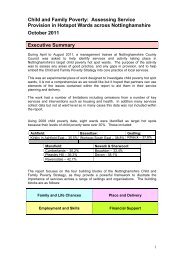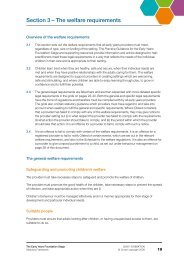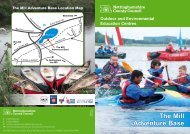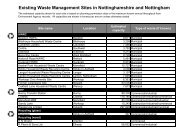Flooding: Drainage & Watercourses - Nottinghamshire County Council
Flooding: Drainage & Watercourses - Nottinghamshire County Council
Flooding: Drainage & Watercourses - Nottinghamshire County Council
Create successful ePaper yourself
Turn your PDF publications into a flip-book with our unique Google optimized e-Paper software.
31. Gullies connect into highway drains and then into Severn Trent sewers,<br />
watercourses or soakaways, alternatively they can connect directly into<br />
Severn Trent surface water sewers, combined Severn Trent foul and surface<br />
water systems or directly to private estate systems. There are often no<br />
proper records relating to these systems.<br />
32. The <strong>County</strong> <strong>Council</strong>’s Highway <strong>Drainage</strong> Assets include nine highway<br />
drainage pumping stations – which can be subject to different inspection<br />
regimes – and a large number of culverts carrying watercourses across the<br />
highway. Where there are ditches or drains these are often the responsibility<br />
of the adjacent land-owner.<br />
33. The immediate highway cost in dealing with the flooding was £1,071,000.<br />
The capital highway costs to deal with the consequences of flooding are, for<br />
2007/08, £941,000 and for 2008/09 £1,345,000.<br />
34. In order to address highway drainage issues the <strong>County</strong> <strong>Council</strong> has already<br />
appointed a <strong>Drainage</strong> Manager (in line with recommendations of the Pitt<br />
Review into the summer 2007 floods). In addition, the Authority has<br />
purchased a specialist drain cleaning vehicle which has been used to clear<br />
119 drain blockages (since its introduction in August 2007 up to early March<br />
2008). It is interesting to note that 16 of the 119 problems were caused by<br />
drains being damaged by utility works i.e. utility companies laying cables or<br />
pipes.<br />
35. The outstanding issues for highway drainage are as follows: there is no<br />
investment in capital drainage improvements and a lack of capacity in<br />
existing systems. This is combined with the effects of climate change and<br />
increased intensity and frequency of storms.<br />
36. The Select Committee noted the reduction in the frequency of gully<br />
emptying on cost grounds and felt that there would be great benefit in<br />
instituting a spring and autumn clean of gullies.<br />
37. The Select Committee also noted the lack of capital investment in drainage<br />
improvement as a possible area for recommendation.<br />
The Environment Agency<br />
38. On 31 March, Paul Lockhart, Area Flood Risk Manager for the Environment<br />
Agency briefed the select committee on the Environment Agency’s capital<br />
schemes – the Nottingham Left (North) Bank Flood Alleviation Scheme; this<br />
proposed scheme will protect over 16,000 properties from Sawley near the<br />
M1 to Radcliffe Viaduct at Colwick. Additionally, the £14.7m West Bridgford<br />
scheme, to be largely completed in the summer of 2007, will protect 5600<br />
homes.<br />
39. Mr Lockhart recognised that there was no flooding from the Trent itself<br />
during the summer 2007 foods. The Environment Agency has responsibility<br />
for flooding from “main rivers” and in <strong>Nottinghamshire</strong> these include: the<br />
Soar, Idle, Trent and Derwent. Other than the Environment Agency, there is<br />
no single body with a strategic overview thus leaving the EA best placed to<br />
engage in a “holistic” approach to managing flooding.<br />
10













![Every Parent Matters [PDF 463KB] - Nottinghamshire County Council](https://img.yumpu.com/47250686/1/184x260/every-parent-matters-pdf-463kb-nottinghamshire-county-council.jpg?quality=85)


![School Employee Domestic Violence and Abuse Policy [PDF 228KB]](https://img.yumpu.com/46294446/1/184x260/school-employee-domestic-violence-and-abuse-policy-pdf-228kb.jpg?quality=85)
